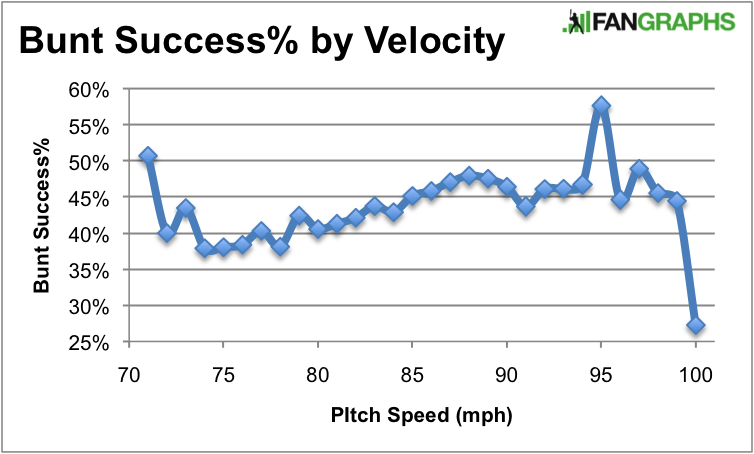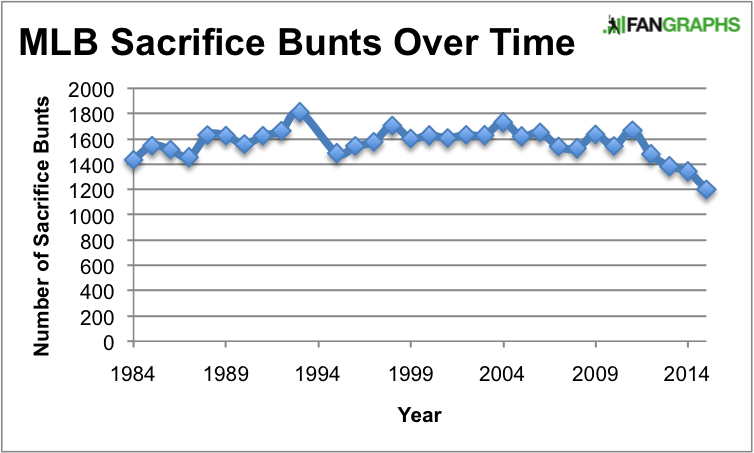Is Baseball Bad at Bunting?
During the fifth inning of Game Two, as Alcides Escobar attempted to bunt against Jacob deGrom, Harold Reynolds decried the current state of bunting in professional baseball. Even after he admitted that hard throwers are hard to bunt on, he went on a mini tirade: “I know it’s hard to get one down against a guy that throws this hard, but I’ve never seen this bad of bunting. Ever. Ever! In baseball, just across the board. I know Escobar can handle the bat, but we see this every night. They have to move the runner. Not just the Royals, but across the board.”
The moment was probably lost for a couple reasons. For one, Escobar decided to swing-away after two failed bunt attempts, and promptly tied the game with a single to center. There was too much excitement to think too deeply about the state of bunting in our game. Now we have a second to breathe, though.
Oh, and a few of us probably missed it because Reynolds has a history of comments that seem to come from another era. Here are a few that demonstrate some of his viewpoints, stolen from an Awful Announcing piece.
I’m being straight up honest. I have no idea what run differential is. – Harold Reynolds
— Heard on MLB Tonight (@HeardOnMLBT) May 23, 2013
“You can talk about on-base percentage all you want, but I didn’t give [Votto] $225 million to put him on base.” – Harold Reynolds
— Heard on MLB Tonight (@HeardOnMLBT) August 17, 2013
“Not bunting is like telling a NFL team they can’t throw deep. The bunt is an offensive weapon.” – Harold Reynolds (h/t @maxdank420)
— Heard on MLB Tonight (@HeardOnMLBT) September 20, 2013
Hey. Look at that. Another quote about bunting. Must have been important to Reynolds when he played. Ah, right, he was 11th in sacrifice hits from 1986 to 1993. He must have really appreciated the heck out of Jay Bell and Felix Fermin.
Anyway, is baseball bad at bunting? We don’t have data on bunting for hits going back very far. For the time period we do have, though, it looks like baseball has actually gotten better at bunting. Here, success is a hit, divided by all bunts put into play.
The past four years have been baseball’s best years for bunting for a hit! Well, the sample is small if you’re talking about a fundamental skill across baseball. Especially since baseball has changed a bit recently.
Consider the shift: It opens up an entire half of the infield, should a batter want to bunt. Once again, we are limited to a small sample, since we have numbers on shifts going back four years. But as the number of shifts has nearly doubled since 2012 (from 8,365 to 15,539 last year), bunts into the shift have only increased from about 60 a year 109 this past year. That might be enough to explain away a slight increase in bunt hit percentage, depending on how those extra 40 bunts are distributed.
If you thought the number of bunts into shifts would be higher over the full season, maybe teams are actually only shifting people who won’t bunt. That would make sense. It’s something we’ve heard before, from Charlie Blackmon.
How about velocity and bunts? Joe Sheehan points out that velocity has changed since Reynolds played, and that this is part of the picture.
Ex-hitter analysts who retired bef. 2007 or so played a completely different game. Velocity has changed everything. https://t.co/C9KP2pVLsj
— Joe Sheehan (@joe_sheehan) October 29, 2015
Reynolds even admitted that it was hard to bunt off of a hard thrower like deGrom. And since velocity is up 2 mph in the past decade, it’s fair to assume that it’s up some since 1984, when Reynolds was a rookie.
Let’s define a successful bunt as one that is in play and is not a fly ball. That’s the point, normally, to get the ball on the ground. Even if you’re trying to bunt for a hit. Now let’s bucket success% by velocity.
It looks like velocity doesn’t have a great effect on bunt outcomes. (In fact, maybe pitchers should be throwing breaking balls when the bunt is on?) Of course, there’s a weird spike at 95, where the sample starts to degrade, and the scale of the chart makes it hard to see what’s going on in the 90s. Here’s a table of the 90s alone.

| Velocity | Success% |
| 90 | 46.4% |
| 91 | 43.7% |
| 92 | 46.1% |
| 93 | 46.1% |
| 94 | 46.7% |
| 95 | 57.6% |
| 96 | 44.6% |
| 97 | 48.9% |
| 98 | 45.5% |
| 99 | 44.4% |
| 100 | 27.3% |
If hitting 95 and 96 makes it harder to bunt the ball, it does so on the order of one percentage point. Since 2002, we’ve had 11 bunt attempts on 100 mph pitches according to Baseball Info Solutions, so let’s not lean too heavily on that data point. At least until we get to 98 mph, we have 100 bunt attempts in our sample.
Maybe the shift is making it easier to bunt for a hit, and maybe velocity is making it harder. Either way, it’s definitely true that we are bunting less. In Reynolds’ heyday, there were as many as 300 to 400 more bunts a year than there have been in each of the past three years.
So we know baseball values the bunt less, and that probably means players are a little bit worse at the skill. The sport is not selecting for the bunt, the sport is not demanding the bunt from its players at the same rate, and so players are probably not as good at bunting.
On the other hand, there’s no great evidence this selection has already happened. Players are bunting for hits at a better rate, and despite higher velocity, they’re managing to put the ball in play on the ground about 45% of the time usually. Maybe that’s terrible, but it’s not any more terrible than it was 13 years ago, and we don’t have the data to test it backwards any further. Maybe it’s just a case of the bad bunts standing out a little more, since the sample is 400 bunts smaller in modern seasons than it was when Reynolds was playing the game.
Addendum: another chart, which is inconclusive about the success of bunting. In this chart, success is either a sacrifice, sacrifice with error, or a bunt hit. Divide it by attempts, and we’ve been steady for a decade:
With a phone full of pictures of pitchers' fingers, strange beers, and his two toddler sons, Eno Sarris can be found at the ballpark or a brewery most days. Read him here, writing about the A's or Giants at The Athletic, or about beer at October. Follow him on Twitter @enosarris if you can handle the sandwiches and inanity.





I know the CW is bunting is a terrible idea. Can anyone recommend any articles that support this? Not saying it isn’t true. I just haven’t seen anything directly address the issue.
The current wisdom is that outs are valuable and you shouldn’t be throwing them away. Bunting has its time and place, but some managers are horrible at knowing when that is.
You just need to look at a run-expectancy table. You’ll see that teams lose 10-30% of their expected runs by moving up the baserunners and using up an out. Unless it’s 1st and 2nd with no outs, you need a really bad hitter up to have a bunt make sense consistently.
Also, let’s not forget what should be the one of the largest factors in the decision, which is where you are in the batting order. Mike Trout should never bunt, Yusmeiro Petit should only bunt.
Exactly. People that only look at win expectancy tables forget this major detail.
I’m not sure I understand what you mean here, as this seems more like talent level than spot in order. The more quality hitters you have behind a bunt, the more chance it will work out. If you only have one good hitter after the bunter, they can pitch around or IBB that guy, which makes the bunt less effective. But if you have the middle of your order up after a bunt, there should be plenty of hitters to do the job. Sorry if I’m missing your point…